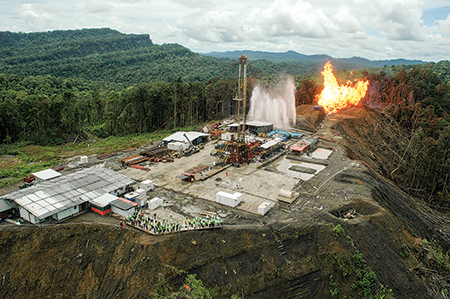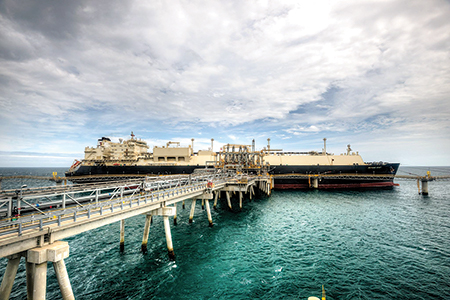Regional focus
E. Gerden, Contributing Writer
The decline of global oil prices has resulted in the suspension of many LNG projects throughout the world. However, LNG production remains profitable in several countries, one of which is Papua New Guinea (PNG).
Australia has traditionally been the largest foreign investor in PNG, with investments over several decades totaling approximately $20 B. A significant portion of this sum was invested in the development of PNG’s mineral resource base. However, in recent years, the situation has changed, as investors from many Western countries have expanded their presence in PNG’s promising LNG industry.
Ongoing gas production and LNG operations in PNG. Among the country’s prominent investors are ExxonMobil and Total, both of which have already launched LNG projects in PNG. Russian state gas monopoly Gazprom has also expressed interest in PNG’s LNG industry. PNG gas fields have lower production costs than those in Australia (about 50% lower) and the EU (about 70% lower), making the country an attractive location for development.
The Elk and Antelope fields (Fig. 1) are the largest discoveries in PNG, and are about half the distance to shore compared with the fields that supply ExxonMobil’s PNG LNG project (Fig. 2). An LNG project sourcing feedstock from the Elk-Antelope resource basin is one of the few potential LNG projects in the region that is expected to be economically profitable, even at low oil prices. According to estimates by the Russian Ministry of Energy, a two-train Elk-Antelope LNG project would cost less and be more profitable than ExxonMobil’s two-train, 6.9-MMtpy PNG LNG plant.
 |
|
Fig. 1. Elk-Antelope gas development in PNG’s eastern highlands, showing a water curtain during a ground flare operation. |
 |
|
Fig. 2. The PNG LNG project remains a promising opportunity for global majors |
Gazprom pinpoints full-scale LNG production in PNG by as early as 2018, with major sale markets anticipated in China, India and Japan. The Russian government has already conducted preliminary talks with the Japanese government regarding the supply of Russia-produced PNG gas in the form of LNG. Gazprom is considering partnerships with producers already active in PNG, such as ExxonMobil and/or Total.
Potential for PNG M&A. Global oil majors are expected to continue strengthening their positions in the PNG LNG industry by partnering with, or acquiring, local players. One such company is Oil Search, the largest oil and gas exploration and development company in PNG. Oil Search owns more than 25% of ExxonMobil Corp.’s PNG LNG venture and is a partner in two other projects.
The company recently rejected an $8-B bid from Australia’s Woodside Petroleum Ltd., in what would have been the biggest energy acquisition in Asia-Pacific, classifying the bid as too low. However, Oil Search’s rejection of the takeover bid could open the door for other global oil and gas majors to consider Oil Search as an acquisition target.
PNG gas targets Asian markets. Oil Search expects PNG LNG project stakeholders to take final decision on a proposed expansion plan by the end of 2017. However, the expansion of Total’s Papua LNG project is expected to be postponed until 2018.
The majority of the gas produced by both projects will be supplied to Japan, which continues to seek opportunities to diversify its supply sources and to reduce its reliance on Australia, which is anticipated to surpass Qatar this decade as the world’s largest LNG exporter.
The establishment of gas production in PNG may provide Russia with new sales markets in the Asian region and, in addition to low production costs, will be associated with logistics benefits. Unlike rival LNG suppliers in the Middle East, shipments to Asia from PNG will not pass through the Malacca Strait choke point near Singapore, resulting in significantly lower shipping costs.
FLNG proposals. The development of PNG’s LNG industry is also expected to be accelerated through the possible introduction of floating LNG (FLNG) technology in the PNG offshore sector.
As part of these plans, Cott Oil and Gas (an Australian private company exploring opportunities within the greater Westralian Superbasin), is planning the introduction of an FLNG solution for the Pandora gas field offshore PNG.
Analysts still believe that the implementation of the majority of LNG projects in Asia-Pacific countries will be delayed by low oil prices. However, many global majors are still looking at oil production in PNG, as domestic oil production could easily compete with Iranian or Saudi grades, in terms of the quality and production costs.
According to the PNG government’s initial plans, the majority of gas produced in the country would have been supplied to nearby Australia by pipeline. However, growing global demand for LNG, especially from southeast Asia, is combining with a large drop in gas output from Indonesia to make PNG LNG more attractive. GP




Comments